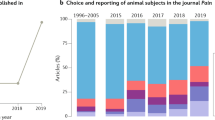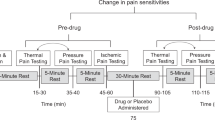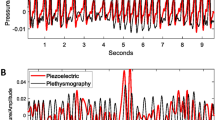Abstract
Quantitative trait locus mapping of chemical/inflammatory pain in the mouse identified the Avpr1a gene, which encodes the vasopressin-1A receptor (V1AR), as being responsible for strain-dependent pain sensitivity to formalin and capsaicin. A genetic association study in humans revealed the influence of a single nucleotide polymorphism (rs10877969) in AVPR1A on capsaicin pain levels, but only in male subjects reporting stress at the time of testing. The analgesic efficacy of the vasopressin analog desmopressin revealed a similar interaction between the drug and acute stress, as desmopressin inhibition of capsaicin pain was only observed in nonstressed subjects. Additional experiments in mice confirmed the male-specific interaction of V1AR and stress, leading to the conclusion that vasopressin activates endogenous analgesia mechanisms unless they have already been activated by stress. These findings represent, to the best of our knowledge, the first explicit demonstration of analgesic efficacy depending on the emotional state of the recipient, and illustrate the heuristic power of a bench-to-bedside-to-bench translational strategy.
This is a preview of subscription content, access via your institution
Access options
Subscribe to this journal
Receive 12 print issues and online access
$209.00 per year
only $17.42 per issue
Buy this article
- Purchase on Springer Link
- Instant access to full article PDF
Prices may be subject to local taxes which are calculated during checkout





Similar content being viewed by others
References
Donaldson, Z.R. & Young, L.J. Oxytocin, vasopressin, and the neurogenetics of sociality. Science 322, 900–904 (2008).
Caldwell, H.K., Lee, H.-J., Macbeth, A.H. & Young, W.S. III. Vasopressin: behavioral roles of an “original” neuropeptide. Prog. Neurobiol. 84, 1–24 (2008).
Tribollet, E., Arsenijevic, Y. & Barberis, C. Vasopressin binding sites in the central nervous system: distribution and regulation. Prog. Brain Res. 119, 45–55 (1998).
Young, L.J. & Wang, Z. The neurobiology of pair bonding. Nat. Neurosci. 7, 1048–1054 (2004).
Thompson, R.R., George, K., Walton, J.C., Orr, S.P. & Benson, J. Sex-specific influences of vasopressin on human social communication. Proc. Natl. Acad. Sci. USA 103, 7889–7894 (2006).
Walum, H. et al. Genetic variation in the vasopressin receptor 1a gene (AVPR1A) associates with pair-bonding behavior in humans. Proc. Natl. Acad. Sci. USA 105, 14153–14156 (2008).
Kemppainen, P., Pertovaara, A., Huopaniemi, T., Hamalainen, O. & Gronblad, M. Human pain thresholds after the application of lypressin, a vasopressin analogue. Pharmacol. Toxicol. 61, 16–19 (1987).
Pohl, J. et al. Modulation of pain perception in man by a vasopressin analogue. Peptides 17, 641–647 (1996).
Honda, K. & Takano, Y. New topics in vasopressin receptors and approach to novel drugs: involvement of vasopressin 1a and V1b receptors in nociceptive responses and morphine-induced effects. J. Pharmacol. Sci. 109, 38–43 (2009).
Yang, J., Chen, J.-M., Liu, W.-Y., Snog, C.-Y. & Lin, B.-C. Through V2 not V1 receptor relating to endogenous opiate peptides, arginine vasopressin in periaqueductal gray regulates antinociception in the rat. Regul. Pept. 137, 156–161 (2006).
Yang, J. et al. Through the central V2, not V1 receptors influencing the endogenous opiate peptide system, arginine vasopressin, not oxytocin in the hypothalamic paraventricular nucleus involves in the antinociception in the rat. Brain Res. 1069, 127–138 (2006).
LaCroix-Fralish, M.L. & Mogil, J.S. Progress in genetic studies of pain and analgesia. Annu. Rev. Pharmacol. Toxicol. 49, 97–121 (2009).
Mogil, J.S. et al. The melanocortin-1 receptor gene mediates female-specific mechanisms of analgesia in mice and humans. Proc. Natl. Acad. Sci. USA 100, 4867–4872 (2003).
Costigan, M. et al. Multiple chronic pain states are associated with a common amino acid–changing allele in KCNS1. Brain 133, 2519–2527 (2010).
Tegeder, I. et al. GTP cyclohydrolase and tetrahydrobiopterin regulate pain sensitivity and persistence. Nat. Med. 12, 1269–1277 (2006).
Nissenbaum, J. et al. Susceptibility to chronic pain following nerve injury is genetically affected by CACNG2. Genome Res. 20, 1180–1190 (2010).
Mogil, J.S. et al. Heritability of nociception. I. Responses of eleven inbred mouse strains on twelve measures of nociception. Pain 80, 67–82 (1999).
Lariviere, W.R. et al. Heritability of nociception. III. Genetic relationships among commonly used assays of nociception and hypersensitivity. Pain 97, 75–86 (2002).
Mogil, J.S., Lichtensteiger, C.A. & Wilson, S.G. The effect of genotype on sensitivity to inflammatory nociception: characterization of resistant (A/J) and sensitive (C57BL/6) inbred mouse strains. Pain 76, 115–125 (1998).
Wilson, S.G. et al. Identification of quantitative trait loci for chemical/inflammatory nociception in mice. Pain 96, 385–391 (2002).
Nair, H.K. et al. Genomic loci and candidate genes underlying inflammatory nociception. Pain 152, 599–606 (2011).
Fortin, A. et al. Recombinant congenic strains derived from A/J and C57BL/6J: a tool for genetic dissection of complex traits. Genomics 74, 21–35 (2001).
Schorscher-Petcu, A. et al. Oxytocin-induced analgesia and scratching are mediated by the vasopressin-1A receptor in the mouse. J. Neurosci. 30, 8274–8284 (2010).
Balaban, C.D., McBurney, D.H. & Affeltranger, M.A. Three distinct categories of time course of pain produced by oral capsaicin. J. Pain 6, 315–322 (2005).
Abbott, F.V., Franklin, K.B.J. & Connell, B. The stress of a novel environment reduces formalin pain: possible role of serotonin. Eur. J. Pharmacol. 126, 141–144 (1986).
Fanselow, M.S. & Sigmundi, R.A. Species-specific danger signals, endogenous opioid analgesia, and defensive behavior. J. Exp. Psychol. Anim. Behav. Process. 12, 301–309 (1986).
Gamble, G.D. & Milne, R.J. Repeated exposure to sham testing procedures reduces reflex withdrawal and hot-plate latencies: attenuation of tonic descending inhibition? Neurosci. Lett. 96, 312–317 (1989).
Mogil, J.S., Sternberg, W.F., Balian, H., Liebeskind, J.C. & Sadowski, B. Opioid and non-opioid swim stress-induced analgesia: a parametric analysis in mice. Physiol. Behav. 59, 123–132 (1996).
Mogil, J.S. & Belknap, J.K. Sex and genotype determine the selective activation of neurochemically-distinct mechanisms of swim stress-induced analgesia. Pharmacol. Biochem. Behav. 56, 61–66 (1997).
Schmelz, M. Translating nociceptive processing into human pain models. Exp. Brain Res. 196, 173–178 (2009).
Mogil, J.S. & Bailey, A.L. Sex and gender differences in pain and analgesia. Prog. Brain Res. 186, 141–157 (2010).
Frazer, K.A. et al. A sequence-based variation map of 8.27 million SNPs in inbred mouse strains. Nature 448, 1050–1055 (2007).
Wong, G.T. Speed congenics: applications for transgenic and knock-out mouse strains. Neuropeptides 36, 230–236 (2002).
Hu, S.B. et al. Vasopressin receptor 1a–mediated negative regulation of B cell receptor signaling. J. Neuroimmunol. 135, 72–81 (2003).
Campbell, C.M. et al. Polymorphisms in the GTP cyclohydrolase gene (GCH1) are associated with ratings of capsaicin pain. Pain 141, 114–118 (2009).
Shi, M.M., Myrand, S.P., Bleavins, M.R. & de la Iglesia, F.A. High-throughput genotyping for the detection of a single nucleotide polymorphism in NAD(P)H quinine oxidoreductase (DT diaphoresis) using TaqMan probes. Mol. Pathol. 52, 295–299 (1999).
Purcell, S. et al. PLINK: a toolset for whole-genome association and population-based linkage analysis. Am. J. Hum. Genet. 81, 559–575 (2007).
Lariviere, W.R., McBurney, D.H., Frot, M. & Balaban, C.D. Tonic, phasic, and integrator components of psychophysical responses to topical capsaicin account for differences of location and sex. J. Pain 6, 777–781 (2005).
Stern, R.A. Visual Analog Mood Scale (Psychological Assessment Resources, 1997).
Fillingim, R.B. et al. Morphine responses and experimental pain: sex differences in side effects and cardiovascular responses but not analgesia. J. Pain 6, 116–124 (2005).
Acknowledgements
This study was supported by US National Institutes of Health grant NS41670 (R.B.F. and J.S.M.), CTSA grant RR02980 and the Louise and Alan Edwards Foundation (J.S.M.). We thank Pfeiffer of America for providing metered spray pumps.
Author information
Authors and Affiliations
Contributions
R.E.S., M.L.L.-F., S.G.S., J.R., J.-S.A., A.S.-P., K.M., J.C., R.A.B., J.B.M. and W.F.S. conducted the experiments. J.S.M., S.B.S., A.F., W.R.L., C.D.B., I.B. and R.B.F. performed data analyses. J.K.N., C.M.C., R.R.E., J.N. Campbell, M.R.W., I.B. and R.B.F. collected human phenotypic and genotypic data. J.N. Crawley provided transgenic mice and advice on their use. J.S.M., I.B. and R.B.F. supervised the project. J.S.M. wrote the manuscript.
Corresponding author
Ethics declarations
Competing interests
The authors declare no competing financial interests.
Supplementary information
Supplementary Text and Figures
Supplementary Figures 1–10 and Supplementary Tables 1 and 2 (PDF 835 kb)
Rights and permissions
About this article
Cite this article
Mogil, J., Sorge, R., LaCroix-Fralish, M. et al. Pain sensitivity and vasopressin analgesia are mediated by a gene-sex-environment interaction. Nat Neurosci 14, 1569–1573 (2011). https://doi.org/10.1038/nn.2941
Received:
Accepted:
Published:
Issue Date:
DOI: https://doi.org/10.1038/nn.2941
This article is cited by
-
Impact of homeostatic body hydration status, evaluated by hemodynamic measures, on different pain sensitization paths to a chronic pain syndrome
Scientific Reports (2024)
-
Only empathy-related traits, not being mimicked or endorphin release, influence social closeness and prosocial behavior
Scientific Reports (2023)
-
Qualitative sex differences in pain processing: emerging evidence of a biased literature
Nature Reviews Neuroscience (2020)
-
Analgesic effects of optogenetic inhibition of basolateral amygdala inputs into the prefrontal cortex in nerve injured female mice
Molecular Brain (2019)
-
Birth experience in newborn infants is associated with changes in nociceptive sensitivity
Scientific Reports (2019)



